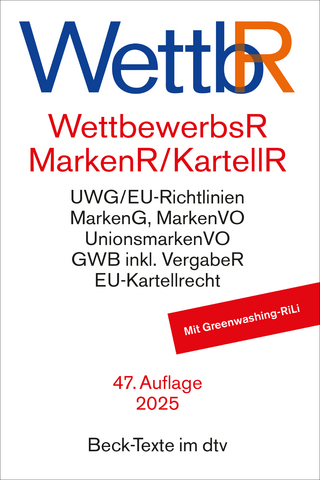
Intellectual Property and Development
Routledge (Verlag)
978-0-367-51342-9 (ISBN)
To answer these questions, this book takes a comparative case study approach and draws upon empirical data collected from 12 GI initiatives in two countries, France and Vietnam. In doing so, this book not only provides new insights and perspectives to the ongoing international legal dispute over GIs, it also contributes to unpacking the factors that make GIs work in practice to bring about economic and non-economic benefits and ultimately support the empowerment of local producers.
This book will be of interest to legal academics and practitioners as well as food sociologists, economists, anthropologists and rural development experts.
Barbara Pick is a consultant for the Food and Agriculture Organization of the United Nations (FAO) and a research associate with the French Agricultural Research Centre for International Development (CIRAD)
Chapter 1 - Introduction: Mapping the legal and development issues surrounding geographical indications
1.1 Protecting GIs: what’s the matter?
1.2 Purpose and contribution
1.3 Methodology
1.4 General contexts in France and Vietnam
1.4.1 France
1.4.2 Vietnam
1.5 Structure and organisation
PART I: The law of GIs in France and Vietnam
Chapter 2 - The legal protection of GIs in France
2.1 Sui generis protection
2.1.1 Link to the geographical area of origin
2.1.2 Choice of the name
2.1.3 Collective action
2.1.4 Product specifications
2.1.5 Quality controls
2.1.6 The right to use and the issue of ownership
2.1.7 Publicness
2.1.8 Absolute protection
2.2 Trade mark protection of GIs
2.2.1 Distinctiveness of geographical names
2.2.2 Ownership
2.2.3 Regulations governing the use
2.2.4 Right to use
2.2.5 Quality controls
2.2.6 Relative protection
Conclusion
Chapter 3 - The legal protection of GIs in Vietnam
3.1 The rigid interpretation of the law
3.1.1 The use of the French terroir approach to Vietnamese sui generis GIs
3.1.2 The convergence of trade marks and GIs
3.2 Top-down management system
3.2.1 Policy intervention for the identification of GIs
3.2.2 The state’s direct control over sui generis GIs
3.2.3 The state’s indirect control over trade marks
3.3 Limitations of the system
3.3.1 The type of protection
3.3.2 Quality controls
3.3.3 Institutional quality
Conclusion
PART II: Case studies: GIs in practice
Chapter 4 - Reasons for seeking GI protection
4.1 Protection of the name against fraud
4.1.1 Pélardon cheese
4.1.2 Bouchot mussels from Mont-St-Michel Bay
4.1.3 Green lentils from Berry
4.1.4 Marseille soap
4.1.5 Fried calamari from Hạ Long
4.2 Marketing and product development
4.2.1 Pottery from Đông Triều
4.2.2 H’mong beef from Cao Bằng
4.2.3 Star anise from Lạng Sõn
4.2.4 Sticky rice from Đông Triều
4.2.5 Vermicelli from Bình Liêu
4.3 Revitalisation of a local industry
4.3.1 Wood from the Alps
4.3.2 Conical hats from Huế
Conclusion
Chapter 5 - Establishing GIs: Dynamics of collective action
5.1 Constitution of the producers’ groups
5.1.1 Participatory and inclusive process
5.1.2 State-driven and technocratic process
5.1.3 Objectives of the producers’ groups
5.2 Elaboration of the product specifications
5.2.1 Negotiations among local actors
5.2.2 Consultations of local actors
5.2.3 Contestation or ignorance of the rules
5.3 Structure of the producers’ groups
5.3.1 Organisational models
5.3.2 Governance: local or state control?
5.3.3 Challenges to collective action
Conclusion
Chapter 6 - Use of GIs on the market: What value for whom?
6.1 Product reputation
6.1.1 Reputation preceding the labelling process
6.1.2 Reputation following the labelling process
6.1.3 Advertising and promotion
6.2 Consumer demand and production capacity
6.2.1 Successful strategies to increase production capacity
6.2.2 Constraints to increasing production capacity
6.2.3 Mechanisms to stimulate demand and increase production
6.3 Marketing channels
6.3.1 Highly local marketing channels
6.3.2 Spatially extended marketing channels
6.3.3 Physical and institutional constraints
6.3.4 Sustainable approach
Conclusion
Chapter 7 - Dormant GIs: Factors and constraints
7.1 The lack of distinctiveness of the name
7.2 The lack of economic incentives
7.3 Marketing channels
7.3.1 Sub-contracting and mass production
7.3.2 Cross-border traffic
7.3.3 Pressure from importers
Conclusion
Chapter 8 - Territorial development, cultural heritage and biodiversity
8.1 Dynamics of territorial development
8.1.1 Drivers and barriers in job creation
8.1.2 Development of new economic activities
8.1.3 Training, innovation and exchange of good practices
8.1.4 Representative capacity and influence
8.2 Preservation of cultural heritage
8.3 Biodiversity conversation
Conclusion
Chapter 9 - Conclusions: Making GIs work in practice
Appendix 1 - List and codification of interviews conducted in Vietnam
Appendix 2 - List and codification of interviews conducted in France
| Erscheinungsdatum | 06.12.2022 |
|---|---|
| Reihe/Serie | Routledge Research in Intellectual Property |
| Zusatzinfo | 3 Tables, color; 5 Line drawings, color; 21 Halftones, color; 26 Illustrations, color |
| Verlagsort | London |
| Sprache | englisch |
| Maße | 156 x 234 mm |
| Gewicht | 453 g |
| Themenwelt | Recht / Steuern ► EU / Internationales Recht |
| Recht / Steuern ► Wirtschaftsrecht ► Urheberrecht | |
| Wirtschaft ► Volkswirtschaftslehre | |
| Weitere Fachgebiete ► Land- / Forstwirtschaft / Fischerei | |
| ISBN-10 | 0-367-51342-0 / 0367513420 |
| ISBN-13 | 978-0-367-51342-9 / 9780367513429 |
| Zustand | Neuware |
| Haben Sie eine Frage zum Produkt? |
aus dem Bereich


